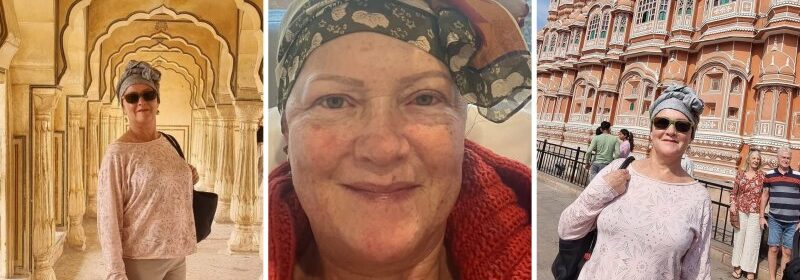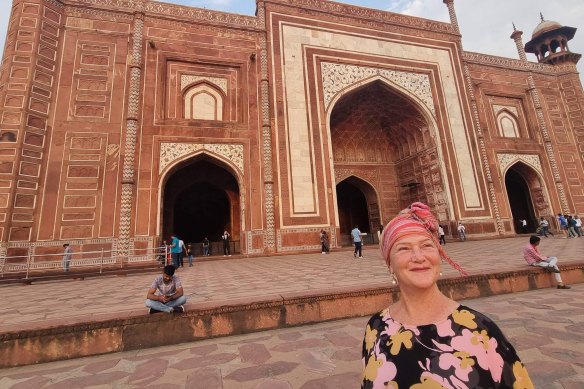New drug gives hope to Australians battling breast cancer

Save articles for later
Add articles to your saved list and come back to them any time.
A new chemotherapy drug has been approved for use in up to 70 per cent of breast cancer cases across Australia, giving hope to patients who were previously excluded from the treatment.
Amy Johnston, 55, is one patient now using Trodelvy after first being diagnosed with stage four metastatic breast cancer in January 2018.
Amy made it to India on her dream trip in 2023.
She had been to the doctors about a distinctive mass in her breast in September 2017 and had a mammogram, but had been told it was all clear.
In 2018, she went back to the doctor because the mass was uncomfortable. An ultrasound, biopsy and further mammogram revealed the mass was cancerous and metastatic, meaning it had spread to other areas of her body including her spine, pelvis and liver.
Johnston started chemotherapy, and has since been on seven different regimes. She was told one of the last options was no longer working at the beginning of the year.
“It was frightening to hear that. We had spent the last year making sure we were having big celebrations for Christmas and birthdays and just making the most out of our time, but nothing can really prepare you for the news,” she said.
It was then that her oncologist told her about Trodelvy. The drug is another form of chemotherapy and was only registered with the Therapeutic Goods Association in Australia in 2022.
At the time, the drug was only available to patients with triple-negative breast cancer, cases which make up around 15 per cent of all metastatic cases, including Johnston’s.
But on Thursday it was announced the drug had now been approved by the association to treat HR+/HER2- breast cancer – which would broaden the scope to 70 per cent of cases.
Johnston was relieved Trodelvy was now available to more patients, as the drug had allowed her more time with her family and the opportunity to travel to India with a friend on her dream holiday in April.
But she pays thousands of dollars for the treatment, only affordable through withdrawing her super after working in a well-paying job for a number of years.
Johnston said it needed to be more accessible for all women, and hoped others who were in her shoes and their families would campaign for more affordable cancer treatments in the Australian market.
“We are the best people to do this, we know how it feels to go through the process and our families know how hard it is to see a loved one go through it. We are the best placed to tell decision makers about our experience and incite change,” she said.
“Any treatment available is a positive, but it is no good if it is inaccessible to many women who need it.”
Harry Perkins Institute Professor Andrew Redfern said it cost $30,000 to access Trodelvy over six rounds.
“It costs $60,000 for the first six treatments, but half is subsidised. After six rounds the drug becomes free if it is still working,” he said.
“Obviously, the aim is to get that number down to $0 for all treatment rounds, but it could take a while to lobby for that.”
Redfern said Trodelvy was more effective than other forms of chemotherapy, with patients able to stay on it for months longer, depending on the case.
“The number of breast cancer cases have been accelerating, which I think is down to the fact that while we have good treatments, we still have no cure,” he said.
“The next stage of trials for Tredolvy will be to look at its effectiveness in preventing the return of cancer cells.”
Despite five-year survival rates for all breast cancers now at 92 per cent, for those with metastatic disease or aggressive subtypes, that figure drops to 30 per cent.
Redfern said metastatic breast cancer needed urgent investment in research, new treatments, and quality support to reverse the devastating statistic.
Pink Hope chief executive Sarah Powell said the number of people who had joined the non-profit organisation’s support groups had increased by 20 per cent over the last year.
She said it was important for patients to have more treatment options available to them to give them a longer and better life.
“The issue with cancer treatments is that the body can become immune over time so the more options that are available the better, until we find a cure,” she said.
“This new drug might give the patient time with their families, it could mean they are able to attend a wedding or meet their grandchild.”
Johnston said while she had plans to travel, whether it be to caves in the Blue Mountains, the Bungle Bungles or the Great Ocean Road, it was more important to continue to see her family achieve milestones.
“My eldest son has a full-time job and my youngest just got an internship in engineering. I am happy to have been able to watch that happen for them,” she said.
“Cancer is very scary and overwhelming, I truly thought I would not be here now.
“You can spend a lot of time dwelling on the sickness and the time you have left, but having the additional treatment options and a great support system is a relief, and I feel a lot of gratitude for that.”
The Morning Edition newsletter is our guide to the day’s most important and interesting stories, analysis and insights. Sign up here.
Most Viewed in National
From our partners
Source: Read Full Article
